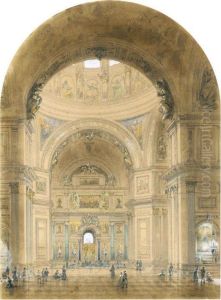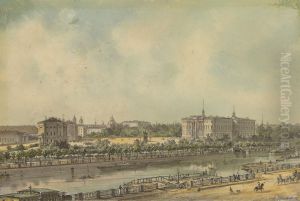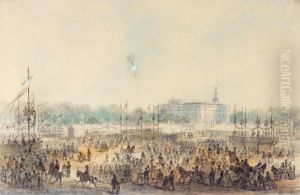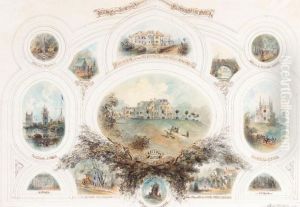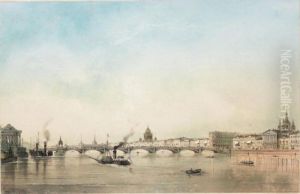Iosif Iosifovic Charlemagne Paintings
Iosif Iosifovich Charlemagne, also known as Joseph-Charles Charlemagne, was a Russian architect and graphic artist of French descent. Born on December 18, 1824, in St. Petersburg, Russia, Charlemagne came from a family deeply involved in the arts; his father, Iosif Ivanovich Charlemagne, was also a well-known architect. This familial background provided the young Charlemagne with an environment that fostered his artistic talents from an early age.
Charlemagne's education began in the realm of fine arts, and he initially trained as a painter at the Imperial Academy of Arts in St. Petersburg. He studied under influential artists and architects of the time, which helped shape his artistic vision and technical skills. Despite his training in painting, Charlemagne's career took a turn towards architecture, where he left a more substantial mark.
Throughout his career, Charlemagne held various positions that allowed him to influence architectural developments in Russia. He was appointed as an academician of architecture by the Imperial Academy of Arts and later took up a role as an instructor at the academy, where he influenced the next generation of Russian architects. His architectural style was characterized by a blend of historicism and neoclassicism, with a penchant for grand and elaborate designs.
Iosif Charlemagne's contributions to Russian architecture include a variety of significant projects, most notably in St. Petersburg. His works encompassed a range of building types, from churches and public buildings to private residences. Among his notable designs are the Pulkovo Observatory, which was completed in 1839, and several buildings along the Nevsky Prospect, St. Petersburg's main avenue.
Aside from his architectural endeavors, Charlemagne was also a prolific graphic artist. He created a number of lithographs and illustrations that depicted various aspects of Russian life, architecture, and history. His graphic works were widely recognized for their attention to detail and historical accuracy, contributing valuable visual records of 19th-century Russia.
Charlemagne's legacy extends beyond his individual contributions; his family continued to be active in the arts for generations. His son, Iosif Iosifovich Charlemagne, became a notable painter and graphic artist, suggesting that the artistic talent within the Charlemagne family was passed down through the lineage.
Iosif Iosifovich Charlemagne passed away on May 3, 1891, in St. Petersburg. His life and works remain a testament to the rich cultural and artistic heritage of 19th-century Russia. Today, his architectural and graphic works are studied by those interested in Russian art history and continue to be appreciated for their historical significance and aesthetic beauty.
